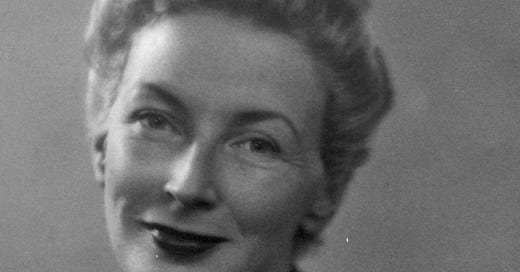Mary Welsh at war
Mary Welsh is best known to history as Ernest Hemingway’s fourth and final wife, but their 15-year union overshadows her own work as a correspondent throughout World War II.
Born in Minnesota on April 5, 1908, Welsh grew up in Thief River Falls and attended Bemidji State before moving on to Northwestern, where she decided to pursue journalism. At 24, she joined the Chicago Daily News as a reporter for the women’s page before moving on to the city desk. Five years later, in 1937, she moved to London and hooked on with Lord Beaverbrook’s Daily Express.
Finally living the foreign correspondent’s life she had dreamed of, Welsh covered the precursors of war in Europe, including the Munich conference in 1938. After the conflict officially began the following year, she wrote slice-of-life war stories from London.
One of them, from December 1939, began: “Emile, who is a human hand grenade, but beautifully polished, is back from the war.”
Though writing from London, Welsh’s obvious fondness for France shows through in this piece and others from the era. It wasn’t long before she convinced her employer to send her across the Channel, where she would cover Royal Air Force units on the Continent before setting up shop in Paris in the spring of 1940.
Also at the front was her husband, the Australian correspondent Noel Monks of the Daily Mail. The pair had married in January 1939 and would see out the war together, though just barely.
In June 1940 they would flee Paris along with the French government and eventually sail back to England from Bordeaux with dozens of other correspondents. Upon her return, Welsh would leave the Daily Express to join the Time and Life staff in London.
When the Blitz began in September 1940, the bombings and their aftermath became her primary focus. As described in Nancy Caldwell Sorel’s book The Women Who Wrote the War, she routinely set out before sunrise to survey the damage from the previous night’s raids.
One morning near Paddington Station she was startled when a small boy of four or five, wearing pajamas, a sweater, and socks but no shoes, ran sobbing toward her. He clutched her knees and gasped, ‘My mum’s down there, my mum’s down there,’ until Mary sat down on a pile of bricks and held him, nuzzling his dirty hair with her nose and repeating, ‘It’s going to be all right, buddy, it’s going to be all right.’
An Air raid warden came along to claim him, assuring her they would have his mother out soon, and that she was ‘not in too bad shape.’ That could be anything short of dead, Welsh thought, as she brushed herself off and headed for the Time-Life office.
In March 1942, Welsh and Helen Kirkpatrick of the Chicago Daily News became the first women accredited as war correspondents by the U.S. Army. This was around the same time the first American troops began arriving in Britain, and Welsh chronicled their experience for anxious readers back home.

Welsh returned to the States herself in the summer of 1942, visiting her parents and Minnesota and spending some time at her employer’s New York office before heading back to England. It was there, in the summer of 1944, that an encounter with another correspondent would change the course of her life.
Noel Monks was away covering the Pacific war, and Welsh reportedly had “given up on her marriage” and enjoyed the company of some of the men in her London orbit. She was dining with one of them, Irwin Shaw, one day in late spring 1944 when he introduced her to Ernest Hemingway. The novelist had just flown over to cover the impending invasion of Europe, leaving his own wife and fellow Collier’s correspondent Martha Gellhorn to make the journey via cargo ship.
Hemingway was smitten immediately, and soon told Welsh he wanted to marry her. It would take nearly two years, not least because both needed to disentangle themselves from their existing marriages, but Papa would eventually get his wish.
Welsh covered the first V-1 rocket attacks on London after D-Day before crossing the Channel later in the summer. More than four years after her flight when the Nazis marched in, she would join the troops liberating Paris in August 1944. It was there that her relationship with Hemingway flourished, and the pair would eventually move in together at the Ritz.
Following the end of the war in Europe, Welsh intended to take a year off from her work at Time, but as it turned out she would never return to the job. She divorced Monks in September 1945 and married Hemingway the following March in Cuba.
That would be their primary home through the summer of 1960, when they relocated to Idaho as Fidel Castro’s revolution made their presence in the island nation untenable. On July 2, 1961, Hemingway shot himself to death in their Idaho home — though Welsh initially told reporters his death was accidental.
She handled his estate after his death, including posthumous publication of multiple books, and wrote her own autobiography, How It Was, in the 1970s.
Welsh died in New York in 1986 at age 78. She is buried next to Hemingway in Ketchum, Idaho.




